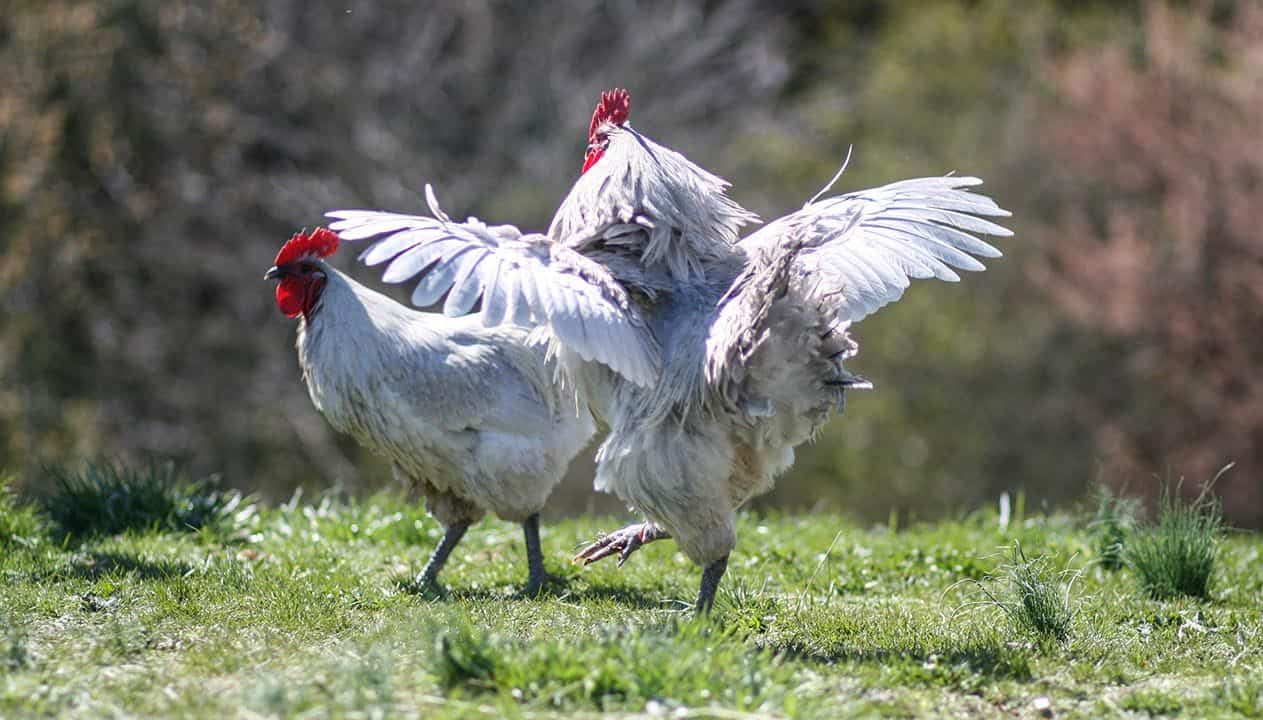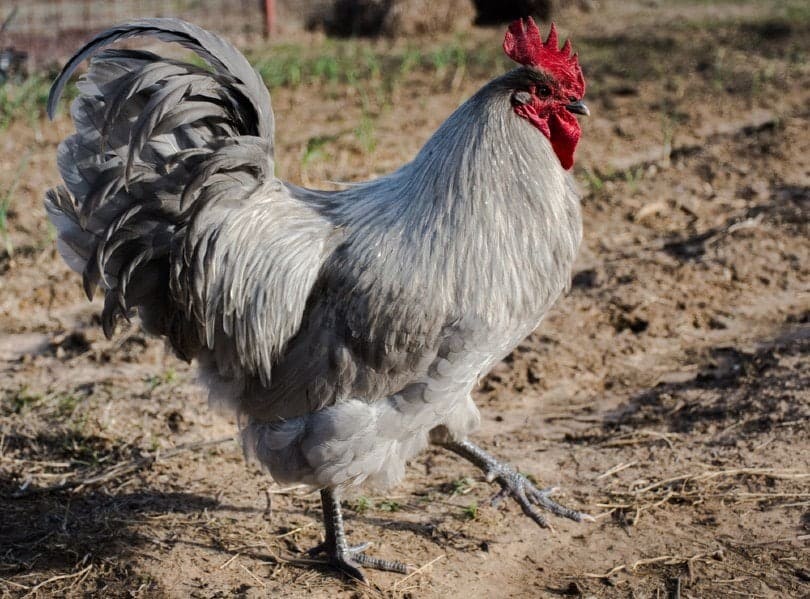Orpington chickens are one of the most popular breeds with backyard breeders due to their hardy disposition and docile demeanor. After years of breeding, these birds now come in a variety of colors. You’ve likely heard of the very common Buff Orpington, but have you ever seen or heard of a Lavender Orpington? These birds are a bit rarer, offering a unique appearance with a muted lavender coloration, though they still display all the same traits that make Orpingtons such a popular breed.

Quick Facts about Lavender Orpingtons
| Species Name: | Gallus gallus domesticus |
| Family: | Orpington |
| Care Level: | Minimal |
| Temperature: | 0-100 degrees Fahrenheit |
| Temperament: | Docile |
| Color Form: | Lavender |
| Lifespan: | 8+ years |
| Size: | 7-10 pounds |
| Diet: | Omnivore |
| Minimum Habitat Size: | 2-3 square feet per bird |
| Habitat: | Chicken coup |
Lavender Orpington Chicken Overview
Lavender Orpingtons are one of the less-seen Orpington variations. They’re excellent birds for backyard poultry farmers, offering adequate egg production and a large body that’s also great for meat harvesting. Just as important for the backyard poultry farmer, Orpingtons are extremely hardy and weather-resistant.
This breed was first created in a small village called Orpington in Kent, England. In the early 1800s, chickens were wildly popular in England, with exotic birds and breeds being crossed to create unique and colorful chickens. But in the late 1800s, things changed to a more utilitarian approach, and birds that produced lots of eggs and meat became far more desirable.
During this time, William Cook created the first Orpington, which was black. This bird was special because of its large size and decent egg-laying ability. At the time, most of the chickens in England were tiny and didn’t offer much sustenance.
In recent years, Orpingtons have grown in popularity again. They were once popular before, but they had become endangered for quite some time. Lavender Orpingtons are a new variety that was only created recently. They’re instantly recognizable due to their purple coloration, which makes them appear quite unique.

How Much Do Lavender Orpingtons Cost?
Despite their rarity, Lavender Orpingtons are not particularly expensive birds. Males generally cost less than $5 as chicks. Hens can be quite a bit pricier, averaging $8-$15 per chick, which is not much more than Orpingtons of any other variety. Generally, you can get them even cheaper if you purchase several, as chickens often come with quantity discounts.
Typical Behavior & Temperament
Lavender Orpingtons are known to be very friendly chickens. They’re happiest in large flocks and are also very easygoing with humans most of the time. Roosters can be territorial; even more so if there’s only one. Aggressive Lavender Orpingtons can be socialized to help even out their temperament.

Appearance & Varieties
Though the lavender variation of the Orpington chicken is one of the most eye-catching, it’s not an officially recognized color for the breed. Still, it’s growing in popularity since people seem to like chickens that not only perform well as egg layers and meat producers, but also exhibit some beautiful and unique appearances.
As the name suggests, Lavender Orpingtons display a light lavender color. Most of them are really gray with a slight lavender tint, though some specimens can display a more truly lavender hue. They sport smooth, broad feathers with feet and shanks that are colored slate or blue. Lavender Orpingtons have a single comb with five points.
On average, roosters weigh 9-10 pounds when fully mature. Hens weigh a bit less at eight pounds on average.

How to Take Care of Lavender Orpington
Habitat, Conditions & Setup
One of the main reasons for the popularity of Orpington chickens is that they’re very easy birds to keep. They’re very resilient to a wide range of weather conditions, and can easily handle harsh winters and hot summers without any issue.
You can keep them in a standard chicken coup with at least two to three square feet of space per bird. Make sure that you’re offering somewhere to get away from the elements. This area must be dry and out of the wind; a place where the birds can get some respite during days of inclement weather.
In addition to the space inside the coup, your birds will need access to a larger area where they can roam and graze. For this larger chicken run, you’ll need about 10 square feet per chicken. Many people opt for movable chicken trailers that allow you to transport the chicken coup and run to a new area each day with ample food to forage.
Lavender Orpingtons can also do well as free-range grazers. They’re hardy chickens that don’t require much. Just provide them with space, food, and protection from the elements, and your Lavender Orpingtons should do well.
Do Lavender Orpingtons Get Along with Other Pets?
Lavender Orpingtons are generally considered to be friendly chickens. As such, they’ll get along with any animals that chickens are generally known to cohabitate with. These birds are often friendly with humans, and are sometimes even awarded pet-like status, sitting on their owner’s laps.
Other animals that a Lavender Orpington might befriend include horses, cows, sheep, donkeys, goats, and even llamas. Of course, this all comes down to the individual temperaments of your birds. Though some Lavender Orpingtons may get along nicely with other animals, not all of them will.
What to Feed Your Lavender Orpington
The number one food choice of your Lavender Orpington will be grasses and weeds. They’ll forage for these plants and even eat their seeds. While foraging, they’ll happily eat many other things they come across, including slugs, earthworms, and all sorts of other insects.
Most chickens in backyards and small farms are also fed the leftover food from the household. Chickens can eat a pretty wide range of foods, but don’t offer them any beans, garlic, onions, or citrus, unless you want your chicken’s eggs to taste strange. And definitely don’t feed your Lavender Orpingtons raw potatoes; these are poisonous to chickens.

Keeping Your Lavender Orpington Healthy
Keeping chickens healthy is a pretty simple task. Chickens are naturally very healthy and hardy animals, so you won’t have to do much to keep them in good shape. They rarely get sick when provided with proper care. Most backyard poultry farmers go years without losing birds to any sort of illness.
Despite their hardiness, chickens are susceptible to some diseases. If one bird gets ill, it could ravage the flock in short order. To prevent this, you’ll want to ensure your chickens have clean living conditions. They also need access to plenty of quality food and clean water.
Adequate space is necessary for healthy Lavender Orpingtons. Avoid putting too many chickens in too small of a space. Don’t allow their area to get wet. Moisture can multiply the bacteria in a chicken coop. And of course, protect them from predators. Chickens make a tasty meal for everything from foxes and coyotes to bobcats and wolves.
Breeding
Hens will produce eggs without the need for a rooster present. Of course, these eggs will not produce baby chicks. They’re great for food, but if you want to breed your chickens, you’ll need a hen and a rooster for fertilization.
During the spring, chickens lay more fertilized eggs than any other time of year, particularly in cold climates. This makes it the best time to attempt breeding.
Pick a rooster for breeding and leave it with your hens. That’s all you have to do. Your rooster will do all of the hard work for you, courting the females, dancing for them, and winning them over. Eventually, your rooster will begin mating with the hens, producing many fertilized eggs for you.

Are Lavender Orpingtons Suitable for You?
If you’re a backyard poultry farmer, Lavender Orpingtons are a great choice for your flock. Whether you want birds primarily for egg production or you plan to raise some for meat, Lavender Orpingtons can fit the bill. They lay about 200 eggs each year and reach 8-10 pounds as adults, making them great dual-purpose chickens.
Thankfully, Lavender Orpingtons aren’t very expensive. They’re very weather-resilient, surviving well in both hot summers and cold winters. Furthermore, they have friendly dispositions and aren’t known to be aggressive, making them an excellent choice for any chicken keeper. The unique lavender coloration is just a bonus.
Featured Image: Racheal Carpenter, Shutterstock
